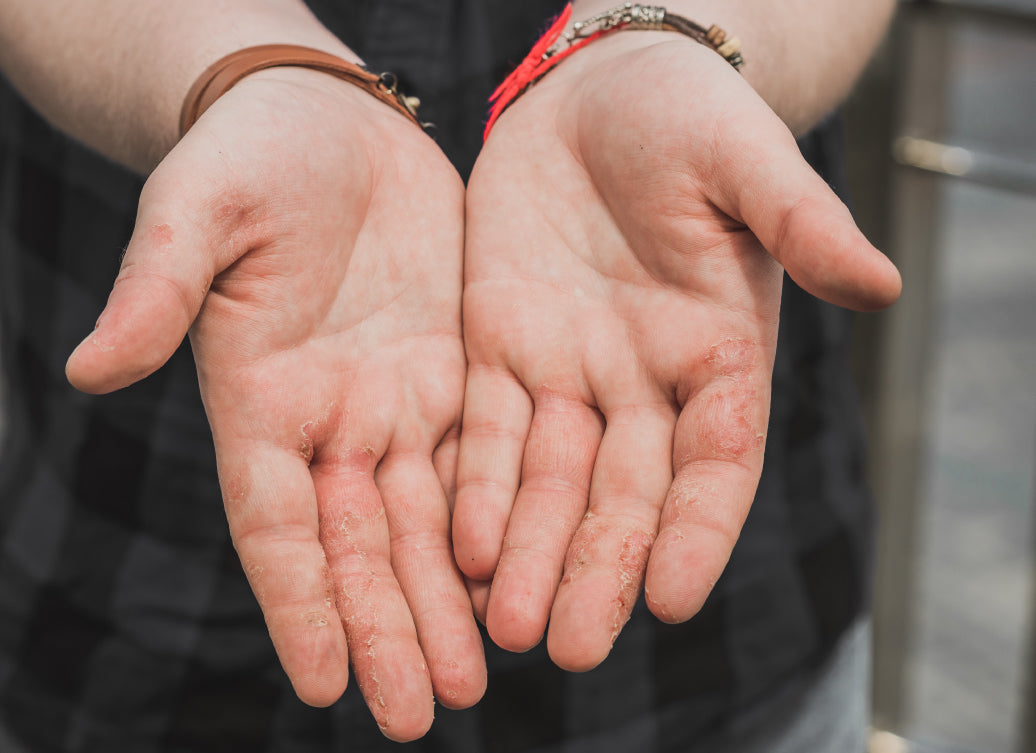Dyshidrosis is a common and often extremely irritating form of eczema, which manifests in itchy, painful skin on hands and feet. In this blog we ask how serious can dyshidrosis get?
What are the symptoms of dyshidrosis?
Dyshidrosis, also known as pompholyx, dyshidrosis, vesicular hand dermatitis or acute palmoplantar eczema, usually begins with very itchy skin on the fingers and toes. Skin can feel hot, painful and stinging as well as itchy. You might be able to see tiny, fluid-filled blisters under the surface of the skin, which can get bigger, more uncomfortable and more painful as time goes on. These blisters can join together, burst and lead to patches of inflamed, crusty, and weeping skin. Eventually the blisters dry up, leaving the skin dry and cracked.
What causes dyshidrosis?
Unfortunately for sufferers, it can be very hard to identify what has triggered an attack of dyshidrosis. Possible culprits include things your skin has been in contact with, soaps, hand washes, hand sanitiser, metals such as nickel and cobalt, industrial chemicals and household detergents, but there are also less obvious explanations such as stress levels, anxiety, humidity, excess sweating and fungal infections.
How bad can dyshidrosis get?
The good news is that for most people, dyshidrosis isn’t a very serious condition, and will resolve itself without treatment. A typical mild case can be itchy and uncomfortable for a few days but not be overly problematic, and will clear up within a week or so.
The not-so-good news is that a severe case of dyshidrosis isn’t very pleasant at all. It can affect the whole palm of the hand or sole of the foot, as well as fingers and toes, and can make life very difficult for anyone having to cope with daily life. Problems with the hands and feet can have a serious impact on all sorts of aspects of life, from making working or walking difficult, to affecting a sufferer’s mental health if they feel very self-conscious of their sore or weeping hands.
Dyshidrosis can be a particular problem for healthcare professionals who have to wash their hands several times a day with harsh detergents or alcohol-based sanitisers, people who have to wear waterproof gloves for their work (which keep their skin damp and hot: ideal conditions for dyshidrosis), and those working with industrial chemicals or metals.
Infection
Although the condition isn’t itself contagious, it is associated with fungal infections which seem to be a possible trigger for flares. Whether an overgrowth of yeasts triggers or exacerbates a flare is unclear, but one line of defence is keeping hands meticulously clean, dry and cool to limit microbial growth.
Dyshidrosis can also get infected with bacteria like Staphylococcus aureus, which would show up with hot, crusty, swollen or weeping skin. A bacterial infection would require treatment from your GP.
Some cases of dyshidrosis can last on and off for months or even years, with not much of a break. For these sufferers, it can be a really quite debilitating condition to live with. In these cases, there are options for medical treatment such as phototherapy, potent steroids, antibiotics, antifungals and immunosuppressants.
Managing dyshidrosis
Managing this complex and painful condition can be a difficult task. For more detailed information about how you can get on top of a flare, check out our article How Do You Get Rid Of Dyshidrotic Eczema?
The short version is that you need to keep your skin clean, dry, moisturised and away from irritants that can aggravate the condition, while also looking at whether your stress levels and diet are playing a part in the flare.
Recommended products for skin prone to dyshidrosis:
Balmonds Skin Salvation
(for the dry, cracked stages)
Balmonds Cooling Cream
(for itchy stage)
Balmonds Natural Shampoo & Body Wash
(to use instead of soap)
Balmonds Scalp Oil
(for clean, nourished skin)
